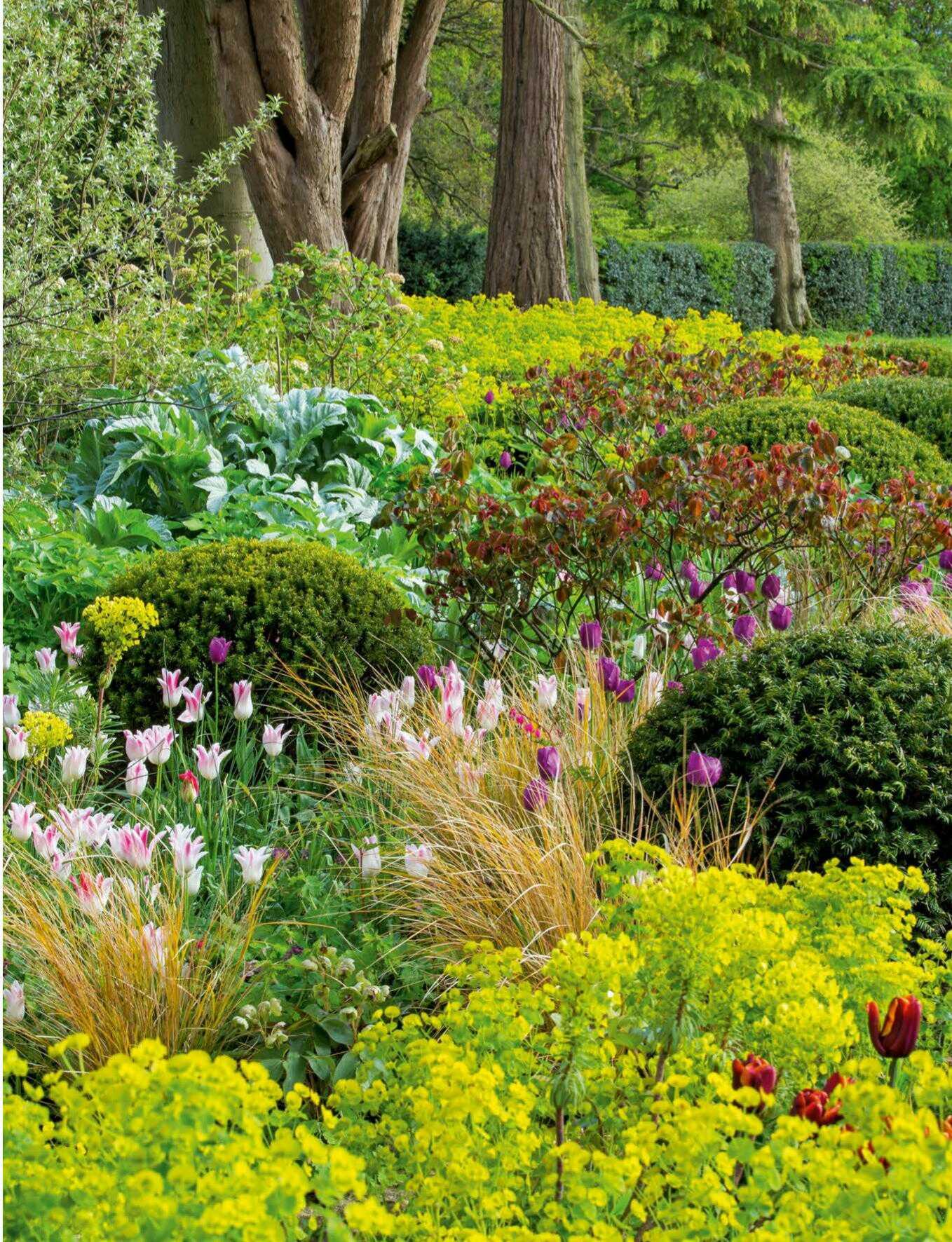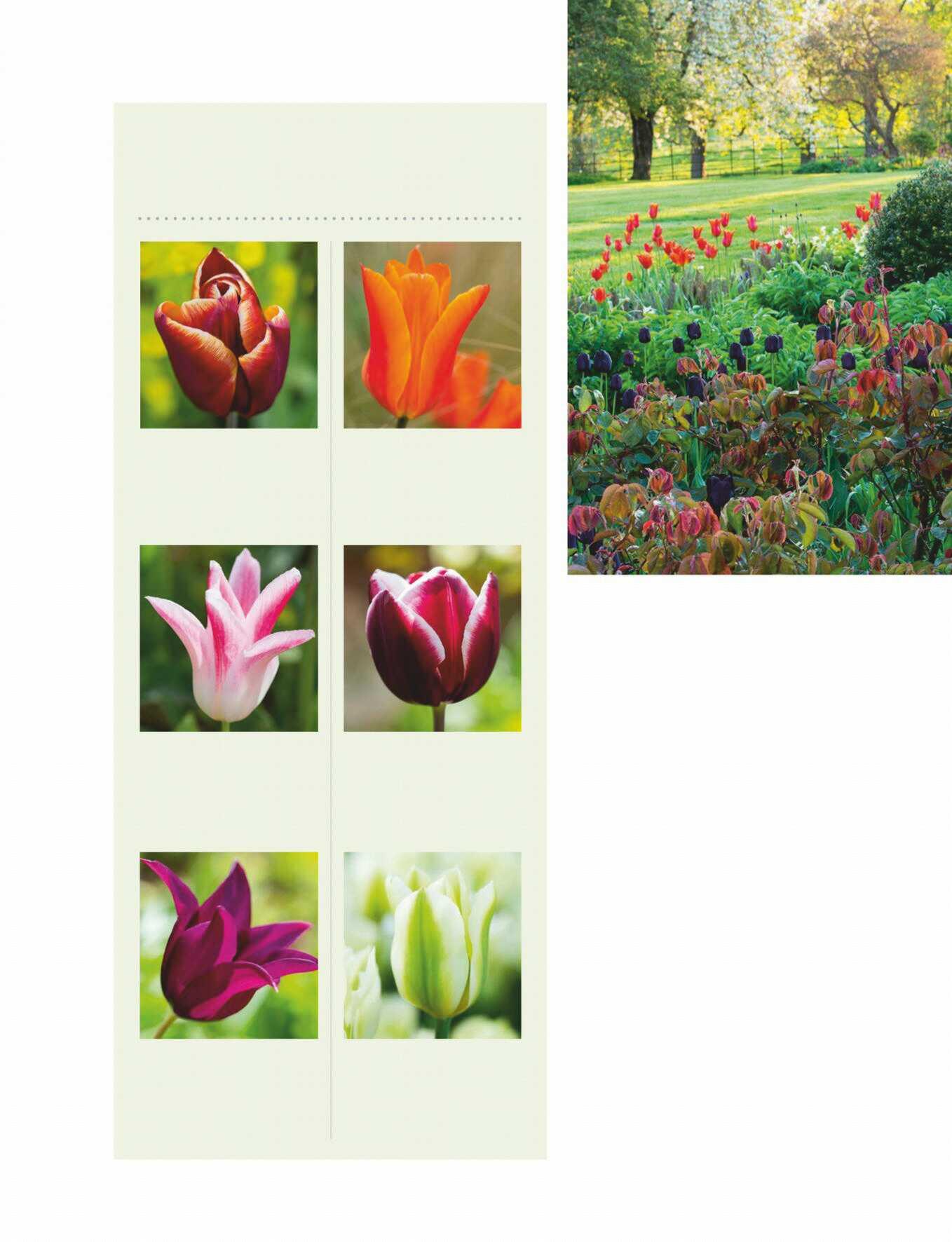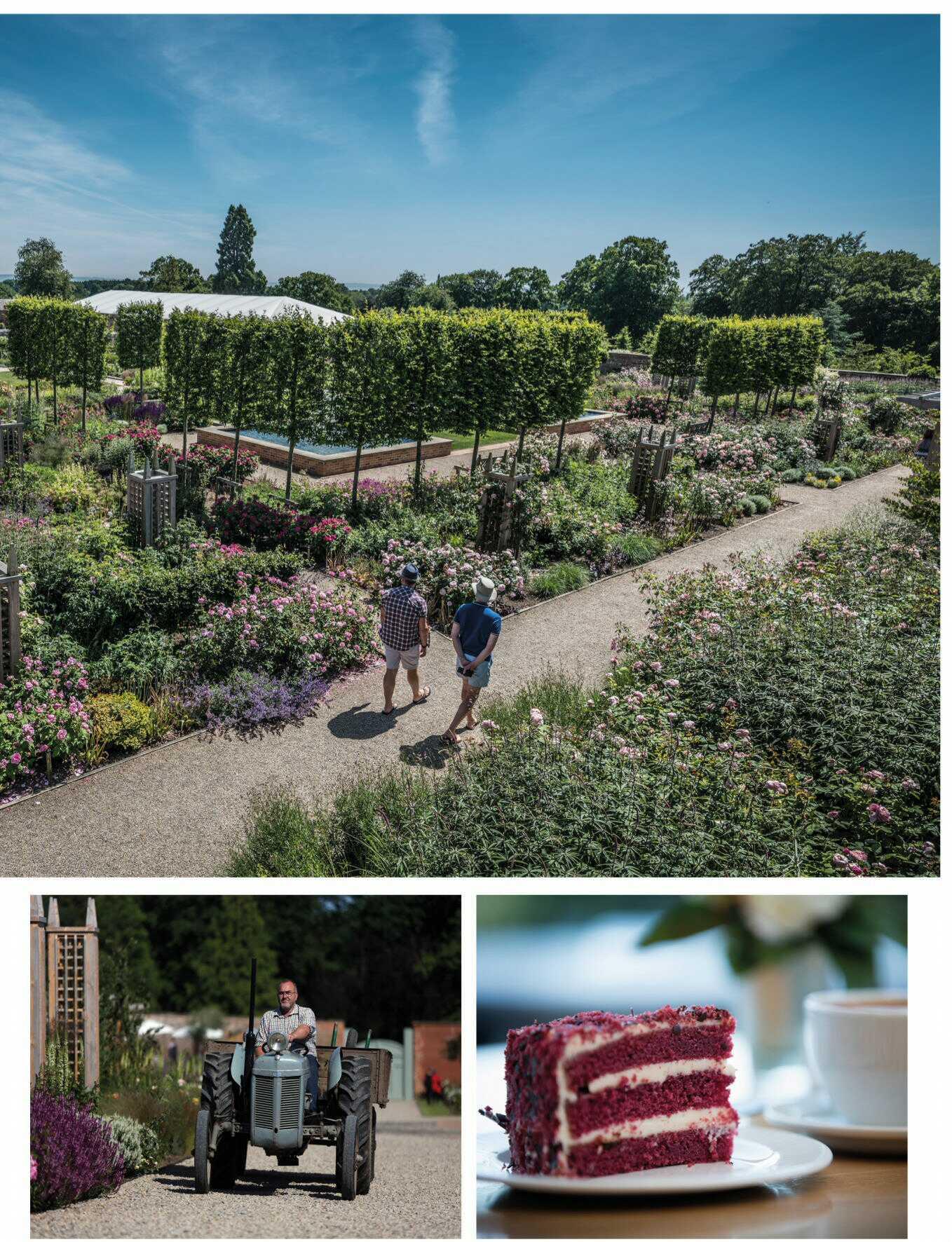
11 minute read
March A garden of colourful
from caszsd
Choice.
Our instant hedging is available to order in a huge range of varieties and sizes, ready-spaced in troughs or Readybags.
Advertisement
Discover a World of Pictorial Meadows...
01386 750585
lindsay@readyhedge.com
matthew@readyhedge.com
www.readyhedge.com
Order your brochure now!
I f y o u l i k e w i l d f l o w e r m e a d o w s , y o u ’ r e g o i n g t o l o v e P i c t o r i a l M e a d o w s
Superior quality designer meadows from seed and PMTurf based on 20 years of research and development
Long flowering season
Designed with pollinators in mind
Available as Seed or PMTurf™
Successional, changing colours
Up to 32 species in every mix
Things to MARCH
Do
Keep up to date in the garden with our monthly guide to key gardening tasks
TAKE basal stem cuttings March is a great time to increase plants that are starting to grow new shoots, such as lupins and delphiniums, by taking basal stem cuttings

Basal cuttings root readily and are a really good way to propagate perennials whose stems turn hollow as they mature, by which point rooting conventional cuttings becomes practically impossible. The technique works very well on lupins, delphiniums, dahlias and chrysanthemums, as well as achillea and gypsophila.
You will need
A sharp knife A dibber A polythene bag A pot containing equal parts peat-free compost and vermiculite or perlite A coldframe or propagator
Method
1 Take the cuttings once the basal stems of the plant are about 10cm high. Using a sharp knife, remove the shoots from as close to the base as possible (above). The parent plant can be in the ground, or you can take basal cuttings from overwintering plants such as dahlias in pots or chrysanthemum stools. 2 Once you have taken three to four cuttings, remove any lower leaves that may end up below the compost surface. 3 Dib the cuttings around the edge of the pot of compost (left), water and cover with a polythene bag. 4 Put the pots in a propagator set to about 12°C or place them on a shady windowsill. Cuttings from hardy perennials can be kept in a coldframe and they should take root within just a few weeks.
Checklist
O Weed, tidy and water bare soil before applying a layer of organic matter, such as well-rotted farmyard manure or garden compost. This will help to reduce water evaporation.
O Support herbaceous perennials by pushing peasticks into the soil around each clump, or use canes, stakes or mesh supports.
O Prune bush and shrub roses, dogwoods and autumn-fruiting raspberries if you haven’t already.
O Now is your last chance to plant bareroot trees, while leaves are yet to form.
O Plant summerfl owering bulbs such as gladiolus (below) and dahlias in March and April in well-drained, sunny garden spots. Planting in succession means they will fl ower over lo ger period.

E A S T L A N G T O N GRANGE
THE GREAT WAVE
Hundreds upon thousands of tulips in jewel tones wash over the Leicestershire garden of Robin and Sally Bowie, delighting owners, designer and visitors alike
WORDS JAMES ALEXANDER-SINCLAIR PHOTOGRAPHS MARIANNE MAJERUS

Let us, for the sake of argument, think of winter as a big heavy coat. Maybe it is made of slightly itchy herringbone tweed: whatever the fabric, it is something a bit steampunk or Sherlock Holmes-y. When we get to this time of year it is becoming cumbersome and the time has come to shrug it o and enjoy something lighter and more colourful. Enough greys and beiges: no more black-branched trees, for we have had our fill of dreary days and freezing nights.
What we all need right now are plants with jewelled colours and joyful demeanours and, I think you will agree, nothing fulfils that particular brief as well as tulips. There is little point in a single tulip: they are a plant that thrives on abundance. Plant not in tens but in hundreds, for they are relatively cheap and simple to grow. Give us seas of amethyst, orange, pearlescent white and shrimp pink crashing like breakers through our borders, for this is the very best way to carry us into a glorious summer. This is a garden that is awash with tulips: many thousands are planted every year not just for the pleasure of the garden owners, but also for the benefit of various local charities, which are also invited to the party.
I have been working with Robin and Sally Bowie in their garden in Leicestershire for over a decade. It is always more fun when a job goes on for years, as we have time to change our minds as time goes on and circumstances change. An interesting thing about designing gardens for people is when to walk away and say “There you go: my work here is done –it is your garden now.” I am quite bad at that and like to pop back to see what is going on. Nowadays I go up there a few times a year when Sally and I drink co ee and wander round Left Purple ‘Negrita’, maroon ‘Abu Hassan’ and pink ‘Holland Chic’ tulips, with clipped yew balls and zingy lime euphorbia flowers.
There was a magnificent a venue of limes, a whopping wisteria, some great steps and plenty of potential. Good bones, in other words

Top A blend of ‘China Pink’, ‘Pink Diamond’ and ‘Menton’ tulips emerge from mounds of geranium foliage. Above Sally Bowie, the garden’s owner.
the garden tweaking plantings and dreaming up new projects. In the past year or so her mind has been preoccupied by a neglected bog garden at the end of the plot and, a few years ago, we planted an arboretum in the field next door.
At the beginning, neither of those projects were on the agenda. I first visited Sally and Robin on a damp March day in 2007. The garden was quite gloomy with some large overgrown evergreens blocking o the road and a couple of trees that were well past their sell-by date. A big sweeping lawn housed swollen hedges, a quietly rotting summerhouse under which a number of foxes happily frolicked, and there was a tired rockery made from concrete boulders. On the plus side, there was a magnificent avenue of limes, a whopping wisteria, some great steps, a good structure of walls and terraces and plenty of potential. Good bones, in other words, so much of the work that needed doing was in the planting rather than in building expensive hard landscaping.
It needed life, colour and a jolly good shake up to make it work for the way they lived. There are three things that need to be considered when designing
Clockwise from top
Tulip ‘Ballerina’ is the perfect partner for the bronze new foliage of roses; magenta tulip ‘Doll’s Minuet’ against a spray of anemanthele; ‘Spring Green’, whiteedged ‘Arabian Mystery’ and ‘Burgundy’ tulips; double ‘Blue Diamond’ tulips with peach ‘Menton’ and aubrieta.

gardens, and the most important is how the owners of the garden are going to use it. Lots of boisterous dogs do not go well with intricate planting; likewise a big, green and tidy sward is frustrating for people who want to grow lovely things and not spend all their lives mowing. We wanted something in between those two extremes: a good slab of grass for summer parties and running children, but enough planting to soften the house (which was quite stern in places). Other parts of the garden have followed in recent years, but the beds in these photographs show the first things they see every time they come home, so they needed to sparkle no matter what season.
The first thing was to get out the chainsaw and start cutting things down. People get very nervous about cutting down trees, but sometimes it is the sensible thing to do – particularly if the tree in question is growing unevenly or at a strange angle. We even felled one enormous and venerable beech, partly because it was diseased but also because it blocked the view of a much better specimen that sat majestically in the lawn and provided a perfect link to the distant farmland. After a fair bit of
East Langton Grange TULIPS
Velvety maroon petals with a feathered golden-yellow edge help to lend these tulips an air of the exotic.

This elegant, lily-flowered tulip in vibrant tangerine, is gorgeous paired with limey spring greens and purples.
Palest pink flowers are enlivened by a flare of magenta on the outside that darkens as the flowers age.
A crisp edge of white on this variety’s plum-red petals adds excitement to any planting scheme.
Another lily-flowered tulip in a rich, jewel-like shade of purple, it also reliably comes back after the first year.
A stalwart variety for spring, with a flash of fresh, vibrant green on the outside of creamy flowers.
destruction it was finally time to put things back. We decided to add in a lot of topiary balls (in yew, box and holly) to give a solid structure to the planting. They frame the front door and then bounce their way happily through all the main borders surrounded by a confection of grasses, roses (mostly the hybrid musk Rosa ‘Penelope’) and herbaceous plants. The idea is that the topiary looks as if it is being swept along on a breaking wave of colour.
Once we had completed the structural planting, the conversation turned to bulbs: the icing on the cake. Yes, we planted loads of da odils, bluebells and snowdrops – a continuing task in the woodland garden – but we needed zing for the borders. Enter the tulips. Lots of them. The sight of sacks of bulbs that need planting can be daunting but the thought of the joy they will bring should be enough to keep you going through a few November afternoons.
A tulip bulb is a lovesome thing – a perfect little nut-brown ball of energy that has to be the best early bulb for mass planting in borders – much better than Above Dark purpleblack tulip ‘Café Noir’ with orange ‘Ballerina’ and newly emerged, red-tinged rose leaves.
da odils. They will be followed by alliums and lilies to keep us going well into the summer. In the first year here, Sally and I sat down together and made a list. But since then the tulips are her department. She has gone from strength to strength and every year more and more bulbs arrive. Borders and pots groan with colour and I take a notebook when I visit as she always comes up with an interesting combination that I can ‘borrow’.
The ground is quite heavy here which means tulips do not do more than a couple of years before they begin to lose their pizzazz. As a result they need to be beefed up every year: where you initially plant 100, then the next year you need to plant 50 more and the next year and the next year, ad infinitum . It sounds relentless, but my goodness it is worth it. Sally has chosen a good range of shapes, from the elegantly curved lily-flowered varieties (such as tulip ‘Ballerina’ or ‘White Triumphator’) to a lovely bit where slightly deranged parrot-flowered varieties tumble into low box hedges.
This is a garden that gives great pleasure to owners, visitors and, indeed, the designer. It is a lovely and well cared for place at all times of the year but, in tulip season, it pushes up a gear and becomes very special indeed. Hooray for spring, hooray for colour and hip-hip-hooray for the tulip. n

Above Lawns sweep away from the house towards mature trees, including this stately copper beech. Right Purple aubrieta, seeded into cracks in the steps near the house. Below Tulip ‘China Pink’ appears delicate but is surprisingly robust.

Set within Wynyard Hall's 150 acres of stunning parkland lies The Gardens - the perfect place to escape, relax with friends or enjoy a family day out. The award-winning Gardens are home to over 3,000 beautiful David Austin roses and a careful selection of shrubs and trees, highlighted with graceful water features and meandering paths. Explore The Woodland Walk- a magical playground where children and adults can explore and create their own exciting adventure. Enjoy a brisk 40 minute walk, or bring a picnic and enjoy a great day out for all the family. With an adjoining cafe serving hot and cold dishes, delicious homemade cakes and beverages and an artisan Farm Shop lled with locally sourced produce, The Gardens at Wynyard Hall are fast becoming one of the North’s leading visitor attractions.
The Gardens are open 7 days a week. Enjoy unlimited visits for a year from just £6 per person. www.wynyardhall.co.uk Tees valley, TS22 5NF










